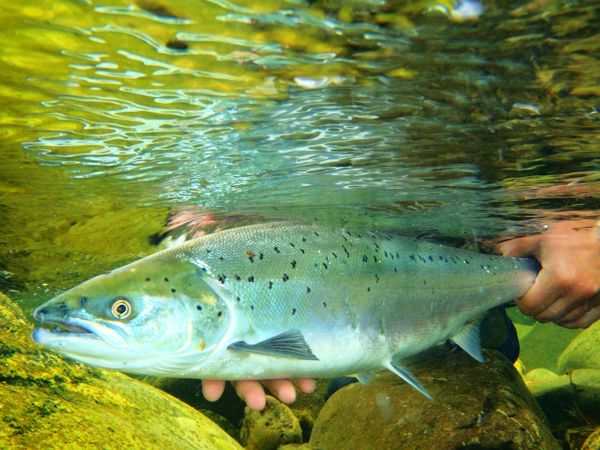Vulnerable salmon and sea trout continue to decline despite conservation efforts from anglers and nets

The latest salmon stock assessments have been published and it is not good news for Welsh salmon rivers.
Natural Resources Wales (NRW) has today (October 7 2024) published the latest 2023 salmon stock assessments that show a continued decline on the country’s 23 principal salmon rivers in Wales.
In 2023 (the latest figures available) Wales recorded the lowest catches of both salmon (252 nets, 848 rods) and sea trout (610 nets, 5,669 rods) since consistent records began in 1970s.
This represents a 4% decline from the previous year, but more worrying shows approximately 70% decline over the past ten years. All 23 Principal salmon rivers in Wales are now categorised as being “At Risk”.
Ben Wilson, principal fisheries advisor for NRW, said:
“Salmon, and their close cousins sea trout (sewin) are iconic and highly prized species in Wales. Their need for cool, clean and healthy freshwater and marine habitats makes them key indicators of environmental quality of our waters, as well highlighting the impact that climate change is having on the aquatic environment.
“Unfortunately, salmon and sea trout numbers are declining in the face of multiple pressures, in 2023 Wales recorded the lowest catches of both salmon (252 nets, 848 rods) and sea trout (610 nets, 5,669 rods) since consistent records began in 1970s.
“Last year Atlantic salmon were reclassified by the International Union for Conservation of Nature from ‘Least Concern’ to ‘Endangered’ in Great Britain as a result of a 30-50% decline in British populations since 2006.”
The decline has continued despite concerted efforts to protect habitats and conservation efforts made by both rod and net fishers. Conservation byelaws passed in 2020 require all net and rod caught salmon to be returned unharmed.
As a result, salmon returning to our rivers have contributed an estimated 8 million eggs over four years and returned fish contributed about 6% of the total estimated egg deposition in Wales in 2023, providing invaluable support in arresting the decline of wild populations.
Sea trout stocks, which were previously considered more robust, are also showing worrying levels of decline.
Wales has 33 main sea trout rivers, 30 (91%) were classed as “At Risk” while only three (9%) of these are deemed to be as “Probably at Risk”, No rivers in Wales are deemed to be “Not at Risk”.
All Welsh stocks are now in serious trouble and at risk of failing to maintain sustainable populations in the future.
Ben added:
“These latest figures are extremely worrying and indicate that many stocks are now in serious trouble and are at risk of failing to maintain sustainable populations in the future.
“Of all the pressures faced by Atlantic salmon and sea trout, climate change impacts in freshwater and at sea appear to be having a devastating effect on stocks, as both our seas and rivers warm up.
“While this is a clear indication that society needs to redouble its efforts to address climate change, our best hope for salmon and sea trout is to tackle the many other factors that we can control.
“We must provide them with cool, clean water in our rivers and continue to address issues like water quality, dams and barriers, exploitation, and invasive non-native species.
“These declines are replicated in most other countries across the North Atlantic distribution of salmon and their European range, where populations have declined over the past few decades.”
The full stock assessment results have been published in the annual salmon stock assessment report for England and Wales that has been co-authored with Cefas and the Environment Agency and can be found here: Salmon Stocks and Fisheries in England and Wales 2023 (publishing.service.gov.uk)
